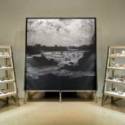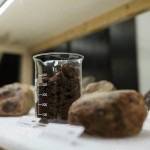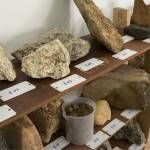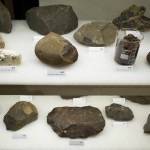
Born in 1976 in São José do Rio Preto, Marcelo Moscheta lives and works in Campinas, just over 90 kilometers from São Paulo. The comings and goings to the state capital via the Bandeirantes or Anhanguera highways, always confronted the artist with the reality of the Tietê river 1,100 kilometers long, which goes across São Paulo from east to west and served as a route for pioneers and also marks the São Paulo cityscape with its unfortunate environmental degradation. Between March and August this year, Moscheta made three trips along the Tietê, from its source in Salesópolis to its mouth on the Parana River. The result of these expeditions can be seen in the Arrasto exhibition, on display at Casa do Bandeirante.
The idea of the trip began to take form in 2012, when Moscheta worked as an assistant to the Portuguese artist Hugo Canoilas, preparing audiovisual materials that later became part of the intervention Pássaros do Paraíso. The work revisited the route taken by the Bandeirantes, and was also presented at Casa do Bandeirante as part of the 30th São Paulo Biennale. “I fell in love with the story,” says the artist, who in 2104 won the scholarship of incentive to Art Production granted by Funarte with a travel project, an installation and a book.
Moscheta traveled 2500 kilometers, with an interval of approximately two months between each trip. Always traveling on his own, he collected rocks, clay, sand and several minerals from both banks of the Tietê and took them to his studio in Campinas, where he photographed, made measurements, having in view the exhibition space that would be granted to the installation, and reviewed the exhibition concepts going through entries in his journals. He devoted six months to the project, a time frame he considers too long compared to the time he usually takes to produce his works. “In general, I work faster and more intensely,” says Moscheta, who, during an artistic residency in Italy, came up with an exhibit in just a month time. “I’m always a little hectic, but I have wanted to do things at a slower pace, however. To reflect better.”
The extended time length allowed not only thoughts, but also new experiences. Moscheta accounts that sometimes he attempted to walk in the shoes of the pioneers, keeping in mind the issue of “subtraction” caused by these explorers in the country side. “But I also related a great deal to the work of Rugendas and Debret” he says. The approach, he points out, had no anthropological or sociological reasoning, he was only “sensitive” and aware of the travel impressions. As, for example, the distinct perception he had of the Tietê’s different sections. “The relationship people have with the river changes along its length. From Mogi das Cruzes to the city of Tietê, it is overlooked. In Barra Bonita, it is used for recreation, with gazebos at the margins, and for transport. I ended up being contaminated by it, so much that I swam in it.”
The resulting art show is like a small museum of curiosities. The expography proposes a “scaled-down” of the two banks of the Tietê, with materials that were collected and documented by Moscheta and arranged on shelves. Despite the reference to the pioneers, says the artist, there is something “negative” to the objects on display, like “spoils of war”. “I try to give a musicological dignity to them, a certain reverence,” says the artist, who echoes the combination of rationality and sensitivity of his father, a botanist. “I sort of become the river itself in order to speak about its resistance. And an image that seemed interesting to include was that of a ghost, which ended up being the waterfall of Salto de Avanhandava in Penápolis, which relives only in times when the dam gates are open. It is on display in archival images, like a ghost of an obstacle, a mighty river, which was domesticated.”
The relationship with the landscape had already been the subject of an exhibit by Moscheta in 2012, at Paço Imperial, in Rio. Curated by Daniela Name, Norte was the result of three weeks of a navigation journey taken by the artist in the Polar Arctic Circle and gave rise to an eponymous publication. It happened the same in Arrasto. “While traveling, I realized that the installation would not be enough, there was a lot of involvement, it was too complex for one layer,” says the artist, whose book has text collaborations of Divino Sobral, Douglas de Freitas and his own, as well as photos and reports.
Arrasto
through december 19
Casa do Bandeirante
Praça Monteiro Lobato, s/n – Butantã – São Paulo/SP
55 11 3031-0920
museudacidade.sp.gov.br/casadobandeirante.php





Deixe um comentário